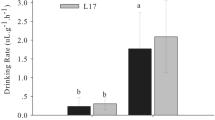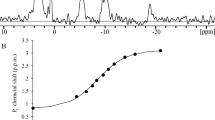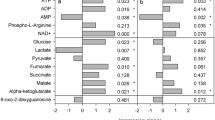Abstract
Ammonia is toxic to all vertebrates. It can be converted to the less toxic urea, but this is a metabolically expensive process1 found only in terrestrial vertebrates that cannot readily excrete ammonia and marine fish that use urea as an osmotic filler. Freshwater fish mostly excrete ammonia2,3 with only a small quantity of urea4,5. It seems the ornithine cycle for urea production has been sup-pressed in all freshwater teleosts6 except for some airbreathers which, when exposed to air, increase urea synthesis via the cycle7. Here we show that the tilapia fish Oreochromls alcalicus grahami, the only fish living in Lake Magadi, an alkaline soda lake (pH = 9.6–10) in the Kenyan Rift Valley, excretes exclusively urea and has ornithine–urea cycle enzymes in its liver. A closely related species that lives in water at pH7.1 lacks these enzymes and excretes mainly ammonia with small amounts of urea produced via uricolysis4. It dies within 60 min when placed in water from Lake Magadi. We suggest that urea production via the ornithine-urea cycle permits O. a. grahami to survive the very alkaline conditions in Lake Magadi.
This is a preview of subscription content, access via your institution
Access options
Subscribe to this journal
Receive 51 print issues and online access
$199.00 per year
only $3.90 per issue
Buy this article
- Purchase on Springer Link
- Instant access to full article PDF
Prices may be subject to local taxes which are calculated during checkout
Similar content being viewed by others
References
Atkinson, D. E. & Bourke, E. Am. J. Physiol. 252 (Renal Fluid Electrolyte Physiol. 21), F947–F956 (1987).
Smith, H. W. J. biol. Chem. 81, 727–747 (1929).
Olson, K. R. & Fromm, P. O. Comp. Biochem. Physiol. 40A, 999–1007 (1971).
Goldstein, L. & Forster, R. P. Comp. Biochem. Physiol. 14, 567–576 (1965).
Cvancara, V. A. Comp. Biochem. Physiol. 30, 489–496 (1969).
Huggins, A. K., Skutsch, G. & Baldwin, E. Comp. Biochem. Physiol. 28, 587–602 (1969).
Saha, N. & Ratha, B. K. J. exp. Zool. 241, 137–141 (1987).
Wright, P. A. & Wood, C. M. J. exp. Biol. 114, 329–353 (1985).
Randall, D. J. & Wright, P. A. Can. J. Zool. (in the press).
Coe, M. J. Acta Tropica 23, 146–177 (1966).
Eddy, F. B., Bamford, O. S. & Maloiy, G. M. O. J. exp. Biol. 91, 349–353 (1981).
Campbell, J. W. in Comparative Animal Physiology (ed. Prosser, C. L.) 279–316 (Saunders, W. B., Toronto, 1973).
Walsh, P. J., Parent, J. J. & Henry, R. P. J. exp. Biol. (in the press).
Verdouw, H., von Echted, J. A. & Dekkers, E. M. J. Water Res. 12, 399–402 (1978).
Chaney, A. L. & Marbeck, E. P. Clin. Chem. 8, 130–132 (1962).
Crocker, C. L. Am. J. med. Technol. 33, 361–365 (1967).
Henry, R. J., Sobel, C. & Kim, J. Am. J. clin. Pathol. 28, 152–160 (1957).
Ritter, N. M., Smith, D. D. & Campbell, J. W. J. exp. Zool. 243, 181–188 (1987).
Mommsen, T. P., Hochachka, P. W. & French, C. J. Can. J. Zool. 61, 1835–1846 (1983).
Webb, J. T. & Brown, G. W. Science 208, 293–295 (1980).
Walsh, P. J., Bedolla, C. & Mommsen, T. P. J. exp. Zool. 241, 133–136 (1987).
Brown, G. W. Jr et al. Science 153, 1653–1654 (1966).
Kun, E. & Kearney, E. B. in Methods of Enzymatic Analysis Vol. 4 (ed. Bergmeyer, H. U.) 1802–1806 (Academic, New York, 1971).
Author information
Authors and Affiliations
Rights and permissions
About this article
Cite this article
Randall, D., Wood, C., Perry, S. et al. Urea excretion as a strategy for survival in a fish living in a very alkaline environment. Nature 337, 165–166 (1989). https://doi.org/10.1038/337165a0
Received:
Accepted:
Issue Date:
DOI: https://doi.org/10.1038/337165a0
This article is cited by
-
Differential DNA methylation and metabolite profiling of Atlantic killifish (Fundulus heteroclitus) from the New Bedford Harbor Superfund site
Ecotoxicology (2024)
-
Acute toxicity of ammonia and nitrite to Siamese fighting fish (Betta splendens)
BMC Zoology (2023)
-
Early onset of urea synthesis and ammonia detoxification pathways in three terrestrially developing frogs
Journal of Comparative Physiology B (2023)
-
An in vitro study of urea and ammonia production and transport by the intestinal tract of fed and fasted rainbow trout: responses to luminal glutamine and ammonia loading
Journal of Comparative Physiology B (2021)
-
Sizes, condition factors and sex ratios of the scattered populations of the small cichlid fish, Alcolapia grahami, that inhabits the lagoons and sites of Lake Magadi (Kenya), one of the most extreme aquatic habitat on Earth
Environmental Biology of Fishes (2019)
Comments
By submitting a comment you agree to abide by our Terms and Community Guidelines. If you find something abusive or that does not comply with our terms or guidelines please flag it as inappropriate.



